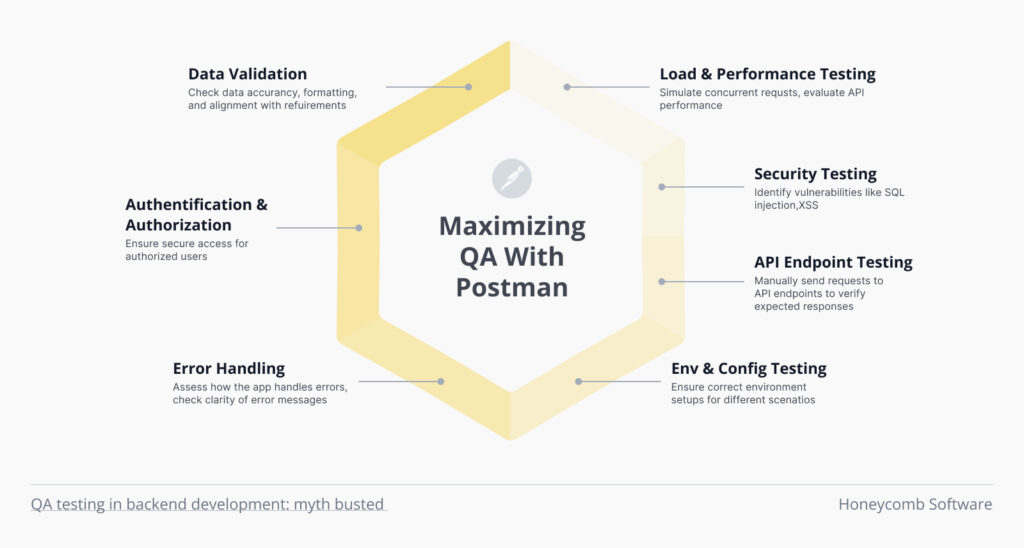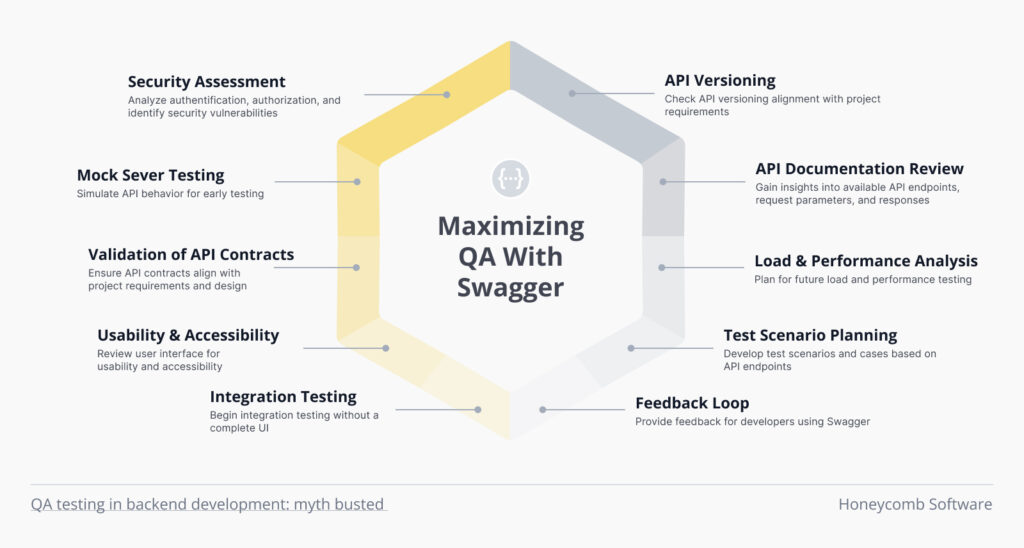
Still holding QA testers back from their backend contribution?
No judgment - practically every company used to apply the traditional end-stage view of QA. Here’s the proof: 2022 stats say 44% of testing teams find it “very challenging” to participate in projects early on.
With this approach, everything’s clear: developers are responsible for building the product, and once they are done, QA engineers are to verify the product works as intended. The bottom line is that QA is a separate phase following development rather than an integrated part of every development phase.
Challenging the stereotype
Typically, you’d associate QA testing with the frontend because that’s where users interact with the app. But software performance seems equally essential – it’s not just about the part users actually see. Everything adds up: you want a reliable product – you bring in the QA testing.
Check the benefits:
- You can detect bugs early, meaning at a point where they are generally easier, faster, and less costly to fix. It’s due to the minor dependent code built on top of potential bugs.
- You boost your security by performing early penetration testing or security audits. It helps uncover vulnerabilities before they can be exploited in a production environment.
- You ensure your app handles expected loads. It’s not too easy to detect performance issues when they’re not visible on the frontend. QA testers can identify database issues, inefficient queries, or problems with concurrent processing so you don’t have to dig in too deep later.
- Your product adheres to specifications for internal & external use. QA testers can perform API testing to verify that these interfaces follow the correct protocols, handle errors, and work efficiently under different conditions.
- You can reduce the risks and save costs. By identifying critical issues early, QA helps mitigate the risks of backend failures. Plus, it cuts the costs of post-release fixes, customer support, and damage control.
QA testing tools you’ll need
What are the best tools now that you want to test the backend?
For example, experienced QA engineers can apply static testing techniques. It entails reviewing the code, documentation, and design when developers aren’t executing the program or the app.
Here’s how testers can do it in static:
- Design reviews. In the design phase, testers can validate the design documents, including architecture and interface designs, to ensure they align with your business requirements.
- Requirement analysis. QA professionals can review the requirements documents to ensure clarity, completeness, and testability. It prevents future changes and detects possible issues before developers create the code.
QA testing with Postman & Swagger
We’ve selected the top tools for dynamic QA testing, i.e., checking the code in a runnable state. With Postman and Swagger, the specialist can conduct API testing and documentation tasks before developers fully launch the frontend or UI.
Here’s how QA testers can use Postman during the early SDLC stages:
Looking for security issues. Testers check for weak spots where attackers might try to break in or disrupt the service. These weak spots often hide in places where bad data inputs or private data leaks might trick the software.
Testing the API endpoints. QA teams can check if software blocks communicating over the network (API endpoints) are working soundly. They do it by sending sample requests and looking at the responses to get back the right data in the correct format.
Data checks. Testers ensure that the information received from these requests is complete and aligns with the software deliverables.
Login checks. Postman helps test if security checkpoints work correctly, ensuring that only the right people can access software parts.
Handling mistakes. QA testers send incorrect data or requests to see how the software reacts. It’s critical for resolving issues efficiently and avoiding their repetition.
Testing under pressure. While Postman is less thorough than other tools designed for this purpose, QA testers can still verify software performance when many users are trying to access it simultaneously. It helps find any reasons for delays or problems when users run software for real.
Preparing the right setting. Finally, QA testers use Postman to ensure the correctness of all settings in different test environments— the developers’, pre-release, and final live versions.

And these are how testers would use Swagger:
Looking at the API instructions. Testers review Swagger documents to understand what different parts of the software’s API can do and what kind of data they should send and receive.
Checking API agreements. They check if the information about the APIs in Swagger matches what the project is supposed to deliver.
Testing with fake servers. Swagger can set up pretend servers that mimic the real API behavior and observe the software’s reaction.
Early integration checks. QA testers can start assembling software pieces and checking how well they work using the API details from Swagger, even before there’s a UI to look at.
Giving feedback. Specialists use Swagger documentation to point out any confusing or missing parts in the API’s design to developers.
Planning test scenarios. Based on Swagger info, QA engineers create specific tests against the API.
Security checks. Testers can understand the system’s protection needs by examining how Swagger describes the API’s security.
Preparing for heavy traffic tests. While Swagger isn’t a load-testing tool, testers can still use it to prepare for QA testing API under pressure.
Checking the interface. They can review the Swagger UI to confirm it’s straightforward, which is a good sign for the final product.
Managing different API versions. QA testers can see how different versions of the API are managed and make sure this matches up with the project’s needs.

Transforming backend outcomes: QA cases
Okay, and how would you apply QA testing in different industry scenarios?
Here are a few examples:
eCommerce
An early QA involvement in an eCommerce company helps find and resolve frequent scalability issues. QA engineers can perform stress and load testing on the backend to ensure the system handles peak shopping periods well. Thus, you prevent potential downtime during critical sales events like Black Friday or Cyber Monday.
Finance
In the financial sector, QA teams often work on backend processes like transaction handling, data security, and regulatory compliance. You could involve a QA team to identify critical flaws in transaction processing that cause significant financial loss or data breaches.
Healthcare
For a healthcare app dealing with sensitive patient data, QA engineers implement automated backend tests to validate the security of data storage and transfer. Their work ensures compliance with health info regulations (like HIPAA in the U.S.) and detects vulnerabilities before the system goes live.
Social media
In this case, the QA team’s early involvement in the backend helps streamline data flow and optimize the performance of the platform’s news feed algorithm. It, in turn, enhances the UX even before making frontend changes.
QA testing beyond the frontend: integration
Hopefully, you’re already reevaluating the backend testing approach. When developing the most suitable implementation methods, you should rely on many factors relevant to your company. Still, there are a few safe strategies that you’ll never regret adopting.
Test-driven development (TDD) emphasizes creating specific tests and types of software testing before the code is written. It promotes better design, higher code quality, and fewer bugs.
Shift-left testing: Starting QA early in the SDLC enables earlier defect detection and reduces the cost and time to fix these issues. It increases the product quality from the start instead of endpoint checks.
Automated regression testing allows for frequent testing without additional manual effort each time there’s a new code commit. This way, the recent code changes don’t break existing functionality.
Seems like a great idea
QA testing, usually done at the end of the development process, has much more to offer earlier. Think of it like this: when QA testing starts early in the making of the software, it becomes a key part of the team that builds the software, not just the one checking it at the end. This change makes the QA tester’s role more important and helps the whole team work better together to create software faster and with fewer problems.
Feel like leveraging QA testing now? We can help.





